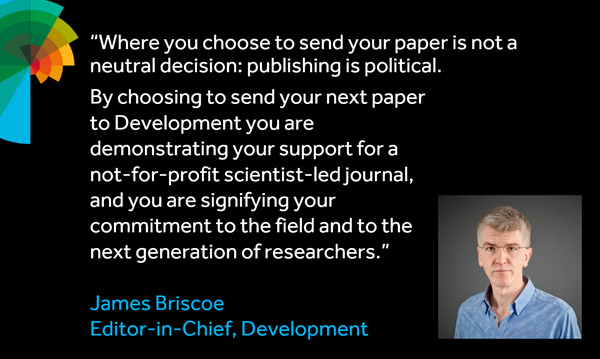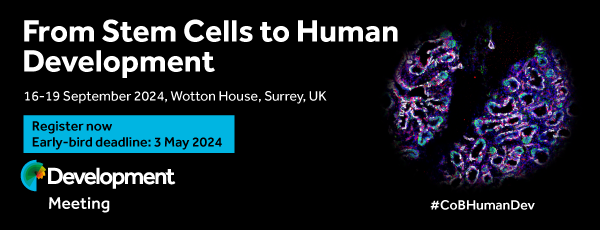Issues
-
Cover image
Cover Image

Cover: Immunostaining of a Drosophila third larval instar eye-antennal disc showing the progression of the morphogenetic furrow by staining for expression of decapentaplegic (dpp), which encodes a ligand for the Transforming Growth factor β (TGFβ) pathway (peach). See research article by Weasner and Kumar (dev199634).
- PDF Icon PDF LinkTable of contents
- PDF Icon PDF LinkIssue info
RESEARCH HIGHLIGHTS
DEVELOPMENTAL TWISTS
INTERVIEWS
HYPOTHESIS
The role of DNA methylation in genome-wide gene regulation during development
Summary: This Hypothesis article describes how global DNA methylation serves as the basis of a master plan for managing the accessibility of genome regulatory elements controlling gene expression profiles during development.
STEM CELLS AND REGENERATION
Hyaline cartilage differentiation of fibroblasts in regeneration and regenerative medicine
Summary:In vivo articular cartilage regeneration serves as a model to develop novel approaches for engineering cartilage to repair damaged joints and identifies fibroblasts as a BMP9-inducible chondroprogenitor.
A single-cell atlas of de novo β-cell regeneration reveals the contribution of hybrid β/δ-cells to diabetes recovery in zebrafish
Highlighted Article: We identified a novel group of plastic cells, which undergo rapid conversion into functional insulin expressing cells. This rapid cell conversion may hold the key to the extraordinary ability of zebrafish to recover from diabetes even after its β-cells are completely destroyed.
Vascular endothelial growth factor c regulates hematopoietic stem cell fate in the dorsal aorta
Summary: VEGFC plays a role in maintaining hematopoietic stem cell fate decisions within the hemogenic endothelium, a finding which may have the potential to improve pluripotent stem cell differentiation protocols.
RESEARCH ARTICLES
The Hox gene Antennapedia is essential for wing development in insects
Highlighted Article: The Hox gene Antp controls the expression of shade to regulate 20-hydroxyecdysone biosynthesis and drives the expression of cuticular protein genes in wing discs.
Aster repulsion drives short-ranged ordering in the Drosophila syncytial blastoderm
Summary: The multinucleated embryo of the fruit fly D. melanogaster distributes nuclei with the help of centrosome-organised microtubule asters, with ordering dynamically adapting to synchronous nuclear divisions, mitotic failures and being independent of cortical actin organisation.
The timing of cell fate decisions is crucial for initiating pattern formation in the Drosophila eye
Summary: A premature switch in the fate of cells along the margin of the Drosophila eye prevents the initiation of pattern formation, indicating that the timing of cell fate decisions is vital for successful eye development.
Stabilization of β-catenin promotes melanocyte specification at the expense of the Schwann cell lineage
Highlighted Article: Activation of β-catenin in bipotent Schwann cell precursors during a specific developmental window induces Mitf and represses FoxD3 to promote melanoblast cell fate at the expense of Schwann cells in limbs.
TMEM8C-mediated fusion is regionalized and regulated by NOTCH signalling during foetal myogenesis
Summary: Myomaker+ fusion-competent myoblasts are preferentially localized to the central part of the foetal muscle, suggesting a central regionalization of myoblast fusion. NOTCH signalling transcriptionally regulates the myomaker-dependent fusion gene.
Pthlha and mechanical force control early patterning of growth zones in the zebrafish craniofacial skeleton
Summary: Embryonic expression of Pthlha precedes Ihha in establishing the negative-feedback loop that regulates endochondral growth zone formation and establishment of this pattern depends on the force of muscle contraction.
Transmural pressure signals through retinoic acid to regulate lung branching
Highlighted Article: This study identifies a previously unreported mechanical signaling pathway through Yap and retinoic acid that regulates lung branching morphogenesis.
Astrocyte-intrinsic and -extrinsic Fat1 activities regulate astrocyte development and angiogenesis in the retina
Summary: Astrocyte-intrinsic and -extrinsic activities of the Fat1 cadherin influence astrocyte migration polarity, proliferation and maturation. Their disruption impacts retinal vascular development and maintenance.
Regulation of retinal amacrine cell generation by miR-216b and Foxn3
Summary: The Foxn3 transcription factor and microRNA miR-216b can modulate formation of amacrine cells in the developing mouse retina, suggesting a new regulatory pathway for retinal interneuron formation.
C2CD6 regulates targeting and organization of the CatSper calcium channel complex in sperm flagella
Summary: C2CD6 contains a calcium-dependent membrane targeting C2 domain and is associated with and regulates the localization and organization of the CatSper calcium channel complex in mouse sperm flagella.
Call for papers: Uncovering Developmental Diversity

Development invites you to submit your latest research to our upcoming special issue: Uncovering Developmental Diversity. This issue will be coordinated by our academic Editor Cassandra Extavour (Harvard University, USA) alongside two Guest Editors: Liam Dolan (Gregor Mendel Institute of Molecular Plant Biology, Austria) and Karen Sears (University of California Los Angeles, USA).
Choose Development in 2024

In this Editorial, Development Editor-in-Chief James Briscoe and Executive Editor Katherine Brown explain how you support your community by publishing in Development and how the journal champions serious science, community connections and progressive publishing.
Journal Meeting: From Stem Cells to Human Development

Register now for the 2024 Development Journal Meeting From Stem Cells to Human Development. Early-bird registration deadline: 3 May. Abstract submission deadline: 21 June.
Pluripotency of a founding field: rebranding developmental biology

This collaborative Perspective, the result of a workshop held in 2023, proposes a set of community actions to increase the visibility of the developmental biology field. The authors make recommendations for new funding streams, frameworks for collaborations and mechanisms by which members of the community can promote themselves and their research.
Read & Publish Open Access publishing: what authors say

We have had great feedback from authors who have benefitted from our Read & Publish agreement with their institution and have been able to publish Open Access with us without paying an APC. Read what they had to say.



